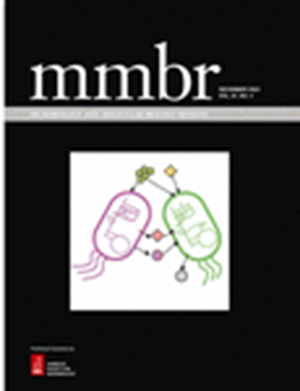厌氧真菌(neocallimastigomyetes)中酶的发现促进了木质纤维素生物炼制的创新。
IF 8
1区 生物学
Q1 MICROBIOLOGY
引用次数: 3
摘要
木质纤维素生物炼制需要创新的解决方案来实现其全部潜力,而新型木质纤维素活性酶的发现可以改善生物炼制的解构过程。酶解植物细胞壁是具有挑战性的,因为半纤维素侧链和木质素中的非碳水化合物键保护不稳定的碳水化合物不被水解。高度特化的降解植物生物量的微生物是改善木质纤维素分解的酶的有吸引力的来源,而厌氧肠道真菌(neocallimastigomyetes)因具有容纳新型木质纤维素活性酶的巨大潜力而脱颖而出。我们讨论了neocallimastigomyetes木质纤维素解构的已知方面,包括它们广泛的碳水化合物活性酶含量,解构复杂木质纤维素的熟练程度,独特的生理学,协同酶复合物和相当大的未表征基因含量。近年来,对新卡马菌及其酶的研究进展迅速,而且只会继续扩大。特别是,厌氧真菌基因组的直接操作,厌氧真菌酶的有效异源表达,以及将木质纤维素的化学变化与真菌基因调控直接联系起来的能力,将加速neocallimastigomyetes木质纤维素活性酶的发现和后续部署。本文章由计算机程序翻译,如有差异,请以英文原文为准。
Enzyme Discovery in Anaerobic Fungi (Neocallimastigomycetes) Enables Lignocellulosic Biorefinery Innovation.
Lignocellulosic biorefineries require innovative solutions to realize their full potential, and the discovery of novel lignocellulose-active enzymes could improve biorefinery deconstruction processes. Enzymatic deconstruction of plant cell walls is challenging, as noncarbohydrate linkages in hemicellulosic sidechains and lignin protect labile carbohydrates from hydrolysis. SUMMARY Lignocellulosic biorefineries require innovative solutions to realize their full potential, and the discovery of novel lignocellulose-active enzymes could improve biorefinery deconstruction processes. Enzymatic deconstruction of plant cell walls is challenging, as noncarbohydrate linkages in hemicellulosic sidechains and lignin protect labile carbohydrates from hydrolysis. Highly specialized microbes that degrade plant biomass are attractive sources of enzymes for improving lignocellulose deconstruction, and the anaerobic gut fungi (Neocallimastigomycetes) stand out as having great potential for harboring novel lignocellulose-active enzymes. We discuss the known aspects of Neocallimastigomycetes lignocellulose deconstruction, including their extensive carbohydrate-active enzyme content, proficiency at deconstructing complex lignocellulose, unique physiology, synergistic enzyme complexes, and sizeable uncharacterized gene content. Progress describing Neocallimastigomycetes and their enzymes has been rapid in recent years, and it will only continue to expand. In particular, direct manipulation of anaerobic fungal genomes, effective heterologous expression of anaerobic fungal enzymes, and the ability to directly relate chemical changes in lignocellulose to fungal gene regulation will accelerate the discovery and subsequent deployment of Neocallimastigomycetes lignocellulose-active enzymes.
求助全文
通过发布文献求助,成功后即可免费获取论文全文。
去求助
来源期刊
CiteScore
18.80
自引率
0.80%
发文量
27
期刊介绍:
Microbiology and Molecular Biology Reviews (MMBR), a journal that explores the significance and interrelationships of recent discoveries in various microbiology fields, publishes review articles that help both specialists and nonspecialists understand and apply the latest findings in their own research. MMBR covers a wide range of topics in microbiology, including microbial ecology, evolution, parasitology, biotechnology, and immunology. The journal caters to scientists with diverse interests in all areas of microbial science and encompasses viruses, bacteria, archaea, fungi, unicellular eukaryotes, and microbial parasites. MMBR primarily publishes authoritative and critical reviews that push the boundaries of knowledge, appealing to both specialists and generalists. The journal often includes descriptive figures and tables to enhance understanding. Indexed/Abstracted in various databases such as Agricola, BIOSIS Previews, CAB Abstracts, Cambridge Scientific Abstracts, Chemical Abstracts Service, Current Contents- Life Sciences, EMBASE, Food Science and Technology Abstracts, Illustrata, MEDLINE, Science Citation Index Expanded (Web of Science), Summon, and Scopus, among others.

 求助内容:
求助内容: 应助结果提醒方式:
应助结果提醒方式:


